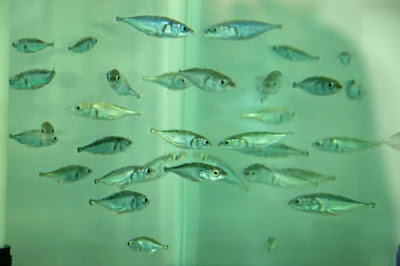
Evolution is usually thought of as occurring over long time periods, but it also can happen quickly. Consider a tiny fish whose transformation after the 1964 Alaskan earthquake was uncovered by University of Oregon scientists and their University of Alaska collaborators.
The fish, seawater-native threespine stickleback, in just decades experienced changes in both their genes and visible external traits such as eyes, shape, color, bone size and body armor when they adapted to survive in fresh water. The earthquake — 9.2 on the Richter scale and second highest ever recorded — caused geological uplift that captured marine fish in newly formed freshwater ponds on islands in Prince William Sound and the Gulf of Alaska south of Anchorage.
The findings — detailed in a paper available online in the Proceedings of the National Academy of Sciences — are important for understanding the impacts of sudden environmental change on organisms in nature, says UO biologist William Cresko, whose lab led the National Science Foundation-funded research.
“We’ve now moved the timescale of the evolution of stickleback fish to decades, and it may even be sooner than that,” said Cresko, who also is the UO’s associate vice president for research and a member of the UO Institute of Ecology and Evolution. “In some of the populations that we studied we found evidence of changes in fewer than even 10 years. For the field, it indicates that evolutionary change can happen quickly, and this likely has been happening with other organisms as well.”
Survival in a new environment is not new for stickleback, a small silver-colored fish found throughout the Northern Hemisphere. A Cresko-led team, using a rapid genome-sequencing technology (RAD-seq) created at the UO with collaborator Eric Johnson, showed in 2010 how stickleback had evolved genetically to survive in fresh water after glaciers receded 13,000 years ago. For the new study, researchers asked how rapidly such adaptation could happen.
The newly published research involved stickleback collected by University of Alaska researchers from freshwater ponds on hard-to-reach marine islands that were seismically thrust up several meters in the 1964 quake.
RAD-seq technology again was used to study the new samples. Genetic changes were similar to those found in the earlier study, but they had occurred in less than 50 years in multiple, separate stickleback populations. Stickleback, the researchers concluded, have evolved as a species over the long haul with regions of their genomes alternatively honed for either freshwater or marine life.
“This research perhaps opens a window on how climate change could affect all kinds of species,” said Susan L. Bassham, a Cresko lab senior research associate who also was co-author of the 2010 paper. “What we’ve shown here is that organisms — even vertebrates, with long generation times — can respond very fast to environmental change.
“And this is not just a plastic change, like becoming tan in the sun; the genome itself is being rapidly reshaped,” she said. “Stickleback fish can adapt on this time scale because the species as a whole has evolved, over millions of years, a genetic bag of tricks for invading and surviving in new freshwater habitats. This hidden genetic diversity is always waiting for its chance, in the sea.”
Co-authors with Bassham and Cresko on the PNAS paper were Emily A. Lescak of UA-Anchorage and Fairbanks; Julian Catchen of the University of Illinois at Urbana-Champaign; and Ofer Gelmond, Frank A. von Hippel and Mary L. Sherbick of UA-Anchorage.
NSF grants DEB0949053 and IOS102728 to Cresko and DEB 0919234 to von Hippel provided the primary funding for the project. National Institutes of Health grant 1R24GM079486-01A1 and the M. J. Murdock Charitable Trust also supported Cresko.
The 2010 study appeared in the PLOS Genetics.
Video
Reference:
Emily A. Lescak, Susan L. Bassham, Julian Catchen, Ofer Gelmond, Mary L. Sherbick, Frank A. Von Hippel, and William A. Cresko. Evolution of stickleback in 50 years on earthquake-uplifted islands. PNAS, December 14, 2015 DOI: 10.1073/pnas.1512020112
Note: The above post is reprinted from materials provided by University of Oregon.










